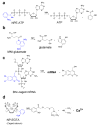Caged compounds: photorelease technology for control of cellular chemistry and physiology
- PMID: 17664946
- PMCID: PMC4207253
- DOI: 10.1038/nmeth1072
Caged compounds: photorelease technology for control of cellular chemistry and physiology
Abstract
Caged compounds are light-sensitive probes that functionally encapsulate biomolecules in an inactive form. Irradiation liberates the trapped molecule, permitting targeted perturbation of a biological process. Uncaging technology and fluorescence microscopy are 'optically orthogonal': the former allows control, and the latter, observation of cellular function. Used in conjunction with other technologies (for example, patch clamp and/or genetics), the light beam becomes a uniquely powerful tool to stimulate a selected biological target in space or time. Here I describe important examples of widely used caged compounds, their design features and synthesis, as well as practical details of how to use them with living cells.
Figures




References
-
- Mayer G, Heckel A. Biologically active molecules with a “light switch”. Angew Chem Int Ed. 2006;45:4900–4921. - PubMed
-
- Berridge MJ, Bootman MD, Lipp P. Calcium-life and death signal. Nature. 1998;395:645–649. - PubMed
-
- Adams SR, Kao JPY, Grynkiewicz G, Minta A, Tsien RY. Biologically useful chelators that release Ca2+ upon illumination. J Am Chem Soc. 1988;110:3212–3220.
-
- Ellis-Davies GCR, Kaplan JH. A new class of photolabile chelators for the rapid release of divalent cations: generation of caged Ca and caged Mg. J Org Chem. 1988;53:1966–1969.
Publication types
MeSH terms
Substances
Grants and funding
LinkOut - more resources
Full Text Sources
Other Literature Sources

